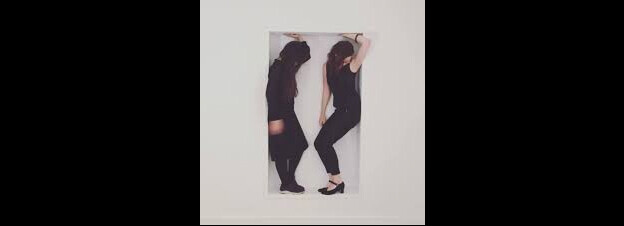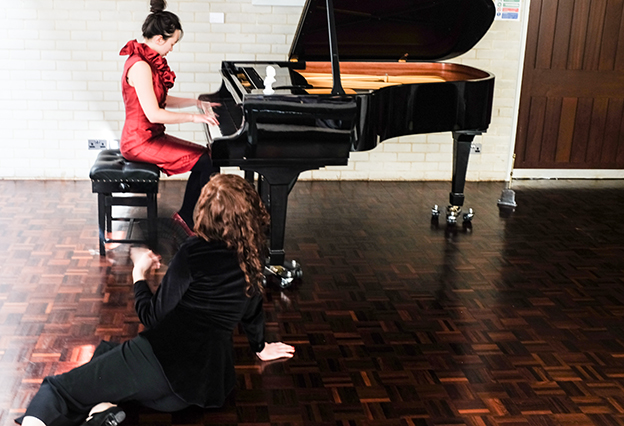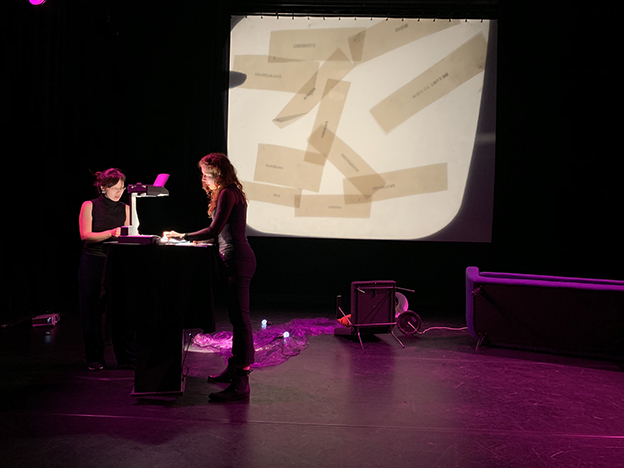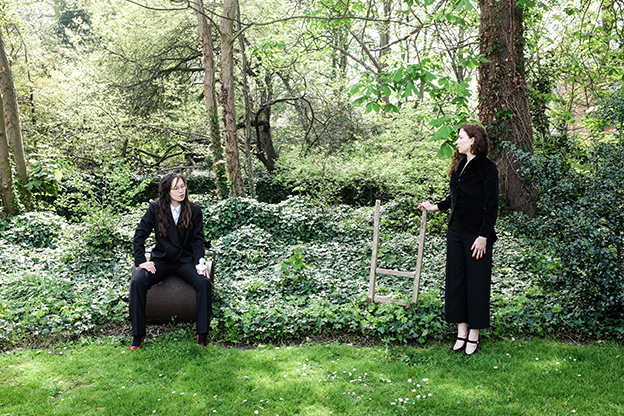Radical reclamations
Queer feminist collaborative acts by Sophie Seita and Naomi Woo

Photos courtesy of Sophie Seita.
I’ve been thinking a lot about the word “reclamation” in the past few days.
“Reclamation” is a word that emerges when there are moments of aesthetic and space making that reflects the “transformation of light into action,” as poet Audre Lorde writes. The feminist and queer acts of collaboration and resistance by Naomi Woo and Sophie Seita shed light on the word “reclaim.” In their brilliant collaborations — across poetry, music, theory, visual art, and performance — they reclaim female artists and other figures into lecture-formances and a feminist epistolary of wit, resistance, and care. Seita and Woo reclaim what’s been lost for queer and feminist artists, and resubvert what’s never been given, and in doing so, they give to us. Going to the standard Webster’s definition, which states “reclaim” is: “the act or process of reclaiming: such as a: REFORMATION, REHABILITATION b: restoration to use: RECOVERY.” Some synonyms include recapture, recoupment, recovery, repossession, retrieval. Perhaps the onslaught of racial and gender violence news during these current pandemic times prompt the reaching towards words that can buoy us, keep us afloat, that can help us reclaim. Artists Seita and Woo in their collaborative performances perhaps provide a feminist salve during these ties, reminding us what’s rightfully ours.

In their current project, “Beethoven Was a Lesbian,” Beethoven is reclaimed as a lesbian through a rich, intellectual, sexy, humorous, intimate, and playful dialogue — that rides the line between a lecture-performance-composition-feminist love letter — across music, space, and poetry. Inspired by the 1970s postcard correspondences between feminist artists Pauline Oliveros and Alison Knowles, which reverted composers like Beetoven, Brahms, and Mozart into women, Seita and Woo continue Oliveros and Knowles’s brazen and needed acts of reclamation and imagination. For Woo and Seita, “Beethoven Was a Lesbian” is part of a series of performance pieces of an ongoing collaboration to restage and performatively translate work by neglected female artists, theorists, musicians, and writers. Seita and Woo remind us that Bethoven was a lesbian, and perhaps aren’t we all?
Both Seita and Woo have active and accomplished practices as feminist artists individually — Woo is a pianist, conductor, and researcher, currently an assistant conductor of the Winnipeg Symphony Orchestra and a lecturer at the University of Manitoba. Her PhD in Musicology is from Cambridge University. Seita is the author of, most recently, My Little Enlightenment Plays (Pamenar, 2020) and Provisional Avant-Gardes: Little Magazine Communities from Dada to Digital (Stanford University Press, 2019), and the editor of The Blind Man reprint (Ugly Duckling Presse, 2017), named one of the Best Art Books of 2017 by the New York Times. As a performer, she’s performed at La MaMa Galleria (NYC), JNU in Delhi, Bold Tendencies, the Royal Academy of Arts among other places, and she is currently an assistant professor at the Boston University. Together, their dynamic works are evocative, and at times, poke fun at the patriarchal and heterosexist world through incisive critique, poetics, and queer imaginations. Earlier collaborative work includes reperforming the exquisite work of Korean American artist and poet Theresa Hak Kyung Cha’s “Reveille Dans la Brûme,” among others in a collaborative partnership since 2018.
Centering queer feminist aesthetics, innovation, and brilliance, the creative partnership of Seita and Woo reclaims and translates feminist artists, and in doing so they create original avant performances needed for our contemporary moment. Through engagement with their work, I’m reminded over and over again of how queer feminist art, and Seita and Woo’s work, is a salve and a balm during these difficult times. Below is a conversation interview with both artists on their collaborative work. Through their textured layered collaborative acts, Seita and Woo do more than reclaim. Their daring and resistant queer and feminist visions reclaim, and in doing so, they help make our worlds anew.
Event documentation and Sound Piece for “Beethoven Was a Lesbian”:
Both your collaborative performance work seems to blend multiple genres and mediums of music, theory, poetics, sound, performance art, and feminist history, and feminist epistolary, which is so exciting, daring, and resistant. Can you both share on the process of collaborating together and across these mediums? How is this a method of making queer? I also see it as an example of queer erotic and pleasure with ideas and art from Audre Lorde mentioned in “Beethoven Was a Lesbian.”
Seita: First of all, thank you so much, Margaret, for inviting us into this conversation, which I see as another extension of queer epistolary friendships. Naomi and I have different creative backgrounds which we’re tying or braiding together in our collaborations. Naomi’s background is in piano, conducting, and musicology; my background is in poetry, literary studies, performance art, and for the last couple of years also increasingly more video work and sound pieces; both of us are interested in performance and feminist/queer studies. A collaboration across mediums and disciplines was an intuitive decision that emerged from our respective practices. I do also have a somewhat-not-quite-acknowledged-but-subliminally-present musical background so perhaps subconsciously for me our ongoing collaboration is also giving me an excuse to dive back into this not-quite-realised musical past. Which maybe brings me to our shared interest in doing something with the past rather than looking at it from a distance.
We’re both interested in tweaking and torqueing what it means to “interpret” or perform a work, our own or that of others. It’s totally a pleasurable thing; collaboration brings me such joy.
While academia often actively discourages collaboration and pleasure, our work positions itself squarely against that institutional valorisation of individualism, hierarchy, competition, and affective severity.
With regard to your question about “making queer” — our piece and our collaboration is definitely queer; it queers the past; it queers the work we touch creatively; it’s invested in the agency and duration implied in the gerund of making, in nonlinear collaborative meandering. But I’m also a little wary of the current trend of calling absolutely everything queer without a grounding in actually lived queer experience. So yes there is a correlation between queer politics and queer forms but it’s usually not that clear-cut or predictable, and for me something isn’t queer if it’s not made by queer people or somehow engages with queer subject matter, however obliquely or resistantly. I don’t want to police the term's applicability, I’m just suspicious of the indiscriminate application of the queer label to art, writing, especially when that label suddenly has a lot of critical purchase and comes with cultural capital. I’m thinking of Ariel Goldberg’s polemic about the label, asking “The question, is the author ‘queer’?, looms a little bit like gossip and a little bit like survival.” I’m really drawn to what Gordon Hall refers to as “queer abstraction” or queer minimalism and how abstract and minimalist sculptures (and I would add: abstract language!) might allow us to see bodies, gender, and sexuality differently.

Your piece “Beethoven Was a Lesbian” draws from numerous figures such as Beethoven, Chopin, Cezanne rewritten as feminist and lesbian, and resistant art strategies from feminist lesbian artists such as Cha and Oliveros. Could you share or reflect on who are the figures you’re both drawn to, and the kinds of work that is generated from either men or women?
Woo: I am obsessed with the logic of the coincidence, and often resistant to “making sense” out of any of the figures to whom I’m drawn … I prefer to think of them as being drawn to me, or drawn to each other.
Seita: I love what you’re suggesting here, Naomi, it’s almost like we’re a witness to some queer magnetism, which we’re only amplifying. Aside from the figures we reference or respond to in our work, thinking through them and alongside them, I’m hesitant to single out my (or our) key influences, but in our work we’re really intrigued by artists, writers, and thinkers who’ve been neglected or who’ve not been considered through performance or who’ve not been paid much attention in a specific different discipline or art practice and largely we’re also attracted to those elements of someone’s practice that perhaps seem rather oblique or quirky or even unartistic. Returning to older works can both be a resistant strategy (resisting a particular narrative or mode of working) and it can be a lifeline that forges new creative kinships.
There seems to be a pedagogical exchange you both have in the letter exchange of “Beethoven was a Lesbian.” For example, Naomi shares her knowledge of musical form, and Sophie explains about her discoveries of archival feminist art. In doing so, the performance seems to evoke a friendship of sharing memories, and melds into a gorgeous cacophony of wit, resistance, intimacy and care. Is it important for you both to share and exchange your respective knowledge as part of the artistic process, and as the art? If so, why?
Seita: What I love about collaboration in general (and our collaboration in particular) is that you constantly learn from the other person, you’re constantly dragged into or out of the mess of your own convoluted desires and investments, to avoid the risk of solipsism or narcissism. Sharing knowledge is also important to me (and I know to Naomi as well) since we’re both also engaged in pedagogy in different institutional contexts. In “Beethoven Was a Lesbian,” that knowledge-sharing is made more explicit than perhaps in other works, mainly because it’s a lecture performance, a genre that is really all about a specific (creative, embodied) performance of knowledge that throws more traditional and exclusive forms of knowledge making and sharing into sharp relief.
Woo: Oh, yes, that’s lovely Sophie! Exactly! I feel as if I am always learning so much from my friends, from you, inside and outside of the text of our works. There is a humility in creation and collaboration that requires acknowledging your own limitations and placing trust in another person. It’s such a gift. And also a humility in pedagogy. Like Sophie, I am also a teacher: I have a lecturing role at the University of Manitoba and am also Music Director of an inner-city music programme in Winnipeg, where I work with students aged five to fifteen. It’s that same “wit, resistance, intimacy and care” that you so beautifully described, Margaret, that I feel with my students.
When did your letters to one another begin? How is the epistolary lesbian or queer form to you both?
Woo: Especially when I travel, collecting and sending postcards is an obsessive pastime of mine. I’ll spend as much time in the gift shop as in many galleries for this reason. The temporality of postal mail has a special draw for me. By the time mail arrives it is always a missive from the past (temporal drag?); when you add the amount of time it normally takes me to find a stamp or find time to stop by the post office, it is often a missive from the very distant past!
Seita: I think the first postcard that you sent me was from Nida in Lithuania at the beginning of our friendship, so in the summer of 2018, and the last one I sent you was a postcard pretending to be written by a nineteenth-century vicar’s wife who’d discovered some information relating to a queer gardening society (which may or may not make it into the new project we’re currently working on). We’re both drawn to the epistolary genre because it exists in this semi-intimate, semipublic space (at least in the case of postcards). Letters have always been places in which intimacy could be negotiated, and in ways both secret and more explicit than any public exchange might allow. So historically, letters between lovers or friends are both a record that queer people existed in different periods, and conceptually, there’s this rich form ready for poetic exploration, because the epistolary exists in this performative address to a “you.”

The intimacy of your exchanges and collaboration is exciting, this question is a bit more explicit about the beginnings of your collaboration: how and when did you both meet? When did you decide to collaborate, and how has the process or partnership evolved from your collaboration on Cha until now?
Seita: We started working together in 2018 as part of a polyphonic festival organised by Lee Ann Brown and Tony Torn at Kettle’s Yard in Cambridge. Lee Ann was the Judith E. Wilson poet in residence at the University of Cambridge that year. The invitation to that festival was to engage with the Kenning Anthology of Poets Theater edited by Kevin Killian, who, along with Dodie Bellamy, was also invited to participate in the festival. It now feels prescient that Naomi and I met through two icons of what I consider to be the Poetry Family (Lee Ann and Kevin — in different though interlinking ways). By that point I had long been interested in the genre of poets theater and while I had moved on to making performance work in a visual art context I felt and still feel this intimate connection with the poetry world. I had heard about Naomi because we were both at Cambridge at the time (Naomi was finishing her PhD and I held a postdoc) and I became super excited about the possibility of collaborating with a musician/musicologist because of the connection I saw between my own work with appropriation and writing through source materials and experimental musicians rethinking the genre of the ‘score’. Both of us were hooked by the question of interpretation and “playing” (with) older material. What’s the relationship between that material and you, when does that material that is not-you become your own? What can we do with a score, how can a text be a score? This then led us to Alison Knowles, Pauline Oliveros, and eventually to our invitation to other artists and poets to send us scores and interpret the ones we shared under the umbrella of the Hildegard von Bingen Society for Gardening Companions.
Woo: Like so many performers, our work changed a lot in 2020. When we were no longer able to visit the cities where we had planned various in-person performances, we coped by developing a new project specifically designed for online sharing and community-building. We were especially lucky to be given a wonderful platform by Bill Bankes-Jones and the team at Tête-à-Tête Opera in London to develop and explore Hildegard of Bingen further. We took lines from her written texts as starting “scores” — invitations for care, as we described them. Things like “in the morning, place a rose petal on your eyes.” We then invited anyone to join us by either participating in these activities, sharing new scores, or both. In this way, we were not so much creators but rather curators, gardeners, cultivators.
“Drag” and “queer” as terms seems to run throughout your projects. Could you both speak about these terms from your respective fields and your respective practices drawing from music, history, theory, performance, and poetry?
Seita: We’ve been thinking about Elizabeth Freeman’s concept of “temporal drag,” how the past exerts a pull upon the present. We start our lecture performance “Beethoven Was a Lesbian” with a quote by W. H. Auden, himself gay and married to the lesbian Erika Mann: “Tristan and Isolde were really a couple of lesbians, because a man making love to a woman couldn’t really get into that rapturous state.” Apart from the camp humour, it’s actually quite perceptive, given the unacknowledged gay subtext of some operas. We read this alongside Wayne Koestenbaum’s brilliant and camp tour de force of opera, The Queen’s Throat, which compares opera divas and drag queens, largely from a gay male perspective.
Woo: I’m primarily a performer of so-called “Classical Music,” which I think is always a kind of temporal drag. My whole life I have been inhabiting different time periods at the piano and on the podium!

I’m struck by not only how intelligence but how humor and playfulness plays a role in the recording. The humor of “Beethoven was a lesbian,” and the line from Naomi “Am I a lesbian or a musician?!” which also resonates with the approach of Oliveros and Knowles postcards. Could you both speak about the role of humor and play in your collaborative work, and is humor and play a feminist lesbian resistance act?
Seita: The line you’re referring to is one of those vexing questions that I feel a lot of artists are asking themselves and that I ask my students to consider: “I needed to work it out. I needed to understand what relationship, if any, I could suppose to exist between my being a lesbian and my being a musician, a musicologist” — it’s a quote from music historian Suzanne Cusick, and we could of course replace musician/musicologist here with poet/artist/filmmaker and “lesbian” with other identity categories. This is a question Cusick and our lecture performance leaves unanswered, necessarily so. How do all these different identity categories we might occupy fade in and out of view and influence each other? And specifically, for an academic, that question of sexuality and pleasure is often relegated to being a subject of the work you study but not connected to your own subjectivity.
In terms of humour, I’m really invested in it as a tool or tone; but humour needs to be buttressed by seriousness (or there needs to be some serious lining underneath that punchy cushion). Humour has also been harnessed by many feminist and queer artists as a strategy. Again, I see this as a necessary counterpoint to academia’s all-too-serious reverence, which so often is anxiety or narrow-mindedness veiled as “rigour” and propriety.
Woo: I recently took a storytelling and comedy workshop (over Zoom) with the incredible Indigenous comedian Issa Kixen. Issa really emphasized the tremendous power of humour as a tool of expression and creativity. The laughter we all shared in the workshop and subsequent performance (even through our computer screens) was also wildly healing, powerfully resonant.
You both have such exciting individual practices and collaborative practices. Could you both share about this practice, and how the collaboration may differ from your individual work, or add to your work, and why the commitment to collaboration?
Woo: I grew up as a pianist, interpreting the music of (primarily) dead white men, and then became an orchestral conductor. These are both inherently collaborative practices, but also interpretative ones; I am mostly reflecting and performing the work of others. It took me a long time to value those practices as also creative, and to recognize that I, too, could create new things. Collaboration is a big part of how the possibilities of creation opened up for me. I had always seen creators/artists/composers as looming men who worked alone. That didn’t look like me! Not just because I am a small, mixed-race Asian woman, but because I work with other people! So, I think that collaboration opened up a distinctly feminist practice for me, in which I realised that women could create things together, that we didn’t have to rely on archaic notions of authorship and ownership …
Seita: I love the idea of collaborating with a printed text on the one hand and collaboration as careful listening and attunement on the other. I’m currently thinking about criticism and pedagogy as creative and collaborative. For our new project, we’re trying to extend our collaboration outward, and work with our audience, in the form of a socially engaged public art project.
Could you reflect on poetics in your collaborative or individual work? I see all of your work as poetics even if some traditionalists may disagree. Could you both reflect on poetics in your work and practices?
Seita: My work is definitely engaged with poetics or could even sometimes be called poetics. It emerges from and thinks about and through poetic form. Poetic thinking is different from prose thinking and I’m always trying to sneak it into my prose and performance.
Any future collaborative projects to look forward to?
Seita: We just received the good news of a grant from the British Council, Canada Council for the Arts, Farnham Maltings, and Canada High Commission in the UK, which will support the next stage in our research into historical and mythical female, queer, and BIPOC gardeners, under the heading of the Minutes of the Hildegard von Bingen Society for Gardening Companions. We’re super excited about this grant because it allows us to do some more research, host community conversations, and to work on a performance, possibly an experimental opera and installation in the form of a gardening talk show.
Any additional information or projects you'd like to add or share?
Woo: Our next project is to conduct further research into the Hildegard von Bingen Society for Gardening Companions. We believe that a whisper network carried on the knowledge and traditions of Hildegard of Bingen, under the guise of gardening together, living together, praying together, writing together, and especially, singing together. The absence of documentation about the activities, membership, and creative work of this society makes it difficult to present our findings in the usual scholarly channels, or to authenticate them by conventional historical means.
Do you know historical women for whom the bonds of female love and anchored roots were so strong that they, too, may have been taking part in the quest to preserve and pass on Hildegard’s musical, mystical knowledge of the gardens? Please do not hesitate to get in touch with us to share any information you might have that would assist in our investigations. As so little information about this collective is written, we are relying on stories, gossip, and hearsay. If any of these have been passed down to you, we are all ears.
Seita: Which recalls a line from Suzanne Cusick that we cite in “Beethoven was a Lesbian”: “What if the ears are sex organs?”
----
Send Sophie and Naomi an email at hildegardsgardeningcompanions@gmail.com
Links:
Buy the postcards here.
New project website.
Naomi Woo is a pianist, conductor, and researcher, currently working as assistant conductor of the Winnipeg Symphony Orchestra and lecturing at the University of Manitoba. Her PhD in Musicology, from Cambridge University, used methodology from literary criticism, queer theory, performance studies, and autoethnography to explore the idea of “impossible performance” in piano etudes by composers including John Cage, György Ligeti, and Nicole Lizée. She has shown interdisciplinary performance work at venues including Somerset House (London), Kettles Yard (Cambridge), and Kunsthalle Darmstadt, and performed as a pianist at Carnegie Hall. She collaborates frequently with artists, choreographers, and composers, including Sasha Amaya, Teppei Higuchi, and Sophie Seita. www.naomiwoo.com
Sophie Seita is a writer and artist who often thinks about how text and the act of reading can be embodied and/or translated into movement, material, sound, and space. She’s performed or exhibited her work at [ SPACE ], La MaMa Galleria (NYC), Printed Matter (NYC), Bold Tendencies, the Royal Academy of Arts, the Arnolfini, JNU (New Delhi), Art Night London, Kunsthalle Darmstadt (Germany), Queer Art Projects, and elsewhere. She’s the author of, most recently, My Little Enlightenment Plays (Pamenar, 2020) and Provisional Avant-Gardes: Little Magazine Communities from Dada to Digital (Stanford University Press, 2019), and the editor of The Blind Man reprint (Ugly Duckling Presse, 2017), named one of the Best Art Books of 2017 by the New York Times. Following her postdoc at Cambridge, she’s currently an assistant professor at Boston University and co-organises the Sound/Text seminar at Harvard. In 2020–2021, she’s part of the Constellations social practice artist development programme run by UP Projects and Flat Time House; an artist mentor at Rupert (Lithuania); and an Eccles Fellow at the British Library, working on a new book of creative nonfiction called Lessons of Decal. www.sophieseita.com
----
Acknowledgments: Thank you to Aleema Arastu for her research assistance on this article.
Automated Poetics